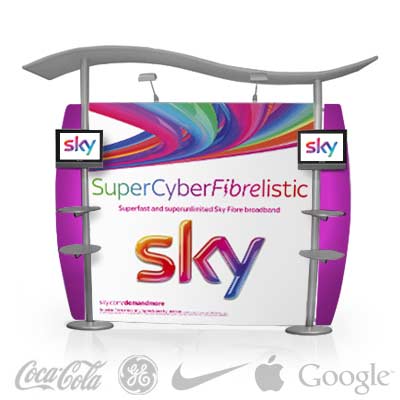Assume you’re setting up your stand at an event, everything looks great until you realise your pull-up banner is either too short or too wide for the space. Frustrating, right? Getting the banner dimensions right is crucial if you want your display to look professional and fit perfectly.
For any business, a pull up banner is one of the easiest ways to get noticed. Whether you’re setting up at an event, a trade fair, or in your own shop, your banner needs to be the right size to make an impact.
If you’ve ever ordered a pull-up banner and weren’t sure what size to choose, you’re definitely not the only one. Between standard banner sizes, roller banner dimensions, and pop-up designs, it can feel a bit overwhelming. Selecting the appropriate pull-up banner size can make or break your display. Go too small, and people may miss your message. Go too big, and it may not fit your stand or space.
In this complete UK guide, we’ll cover the standard pull-up banner dimensions, design tips, and what you need to know before printing your next banner.
Pull-up banners are everywhere: at trade shows, in shops, at conferences, and even at outdoor events. They’re the go-to option for businesses that need a display that draws attention quickly, looks professional, and is simple to set up. Pull-up banners can be used for a variety of marketing and informational purposes, including promoting a product and directing visitors to an event.
So, what exactly defines a pull-up banner?
Simply put, it’s a portable vertical display that collapses into a small, lightweight case for easy transport. The banner itself is usually made of strong vinyl or fabric and extends upward from a retractable base to reveal your printed design. After the event, the banner rolls back down into the case for easy storage or transportation to the next location.
When it comes to pull up banners, size really does matter, not just for looks, but for practicality too. Choosing the wrong banner dimensions can completely change how your display performs at an event or in an in-store setup.
If your banner is too small, it may be overlooked in a busy environment, with people passing by without noticing your message, logo, or offer. Conversely, an overly large banner can create its own problems; it may not fit into your exhibition booth, pop-up stand, or display area, leading to stressful setup and an unplanned appearance.
Portability is another factor that many people ignore. Oversized or awkwardly shaped banners can be difficult to transport between events.
Achieving the correct banner dimensions ensures a smooth transition from setup to display. A properly sized item increases visual impact. It makes your brand appear polished and professional. It also fits your space well and is simple to transport and handle. Choosing the appropriate banner size is critical. It enhances presentation, convenience, and visibility.
Understanding the sizes of pull-up banners can influence how people perceive your message. Every size has a role, from small desk banners to large exhibition backdrops.
Here is a clear table that lists the most popular banner sizes in the UK, their best uses, and quick links to each option at Stand Banner to help you make your choice.
| Banner Type | Common Display Size (W x H) | Best For… | StandBanner.co.uk Product Link |
|---|---|---|---|
| Standard Roll Up | 850mm x 2000mm | Ideal for trade shows, receptions, and retail spaces, it’s the all-rounder that fits most venues. | View 850mm Banners |
| Compact / Desktop | A4, A3, 615mm x 2090mm | Perfect for tabletops, counters, or events with limited floor space. | View Compact Banners |
| Wide Format | 1000mm, 1200mm, 1500mm, 2000mm (Width) | Great for creating large visual backdrops, filling wall spaces, and ensuring maximum brand impact. | View Wide Banners |
| Premium Height | 850mm x 2150mm | Designed for extra visibility in crowds and a more polished, professional appearance. | View Premium Banners |
Each of these banner measurements has a specific purpose, ranging from small, portable options to large-scale displays that draw attention. Understanding your display area and audience allows you to select the banner that will provide the best visibility, balance, and professional impact for your brand.
One of the most common questions people have before purchasing a pull-up banner is, “How easy is it to carry?” It’s a great question because, while your banner may look impressive when displayed, you should also consider how it travels.
This is where the packed dimensions come in. Packed dimensions are the size of the banner when rolled up and stored in its carry case. It indicates how compact and portable your banner will be during transit or storage. The smaller and lighter the packed dimensions, the easier it is to move between events, offices, or exhibition halls.
For anyone who wants the technical details, here’s a quick look at the typical packed sizes and weights of common UK pull up banners.
| Model | Display Size (W x H) | Packed Dimensions (Case) | Approx. Weight |
|---|---|---|---|
| Economy 850mm | 850 x 2000mm | 86 x 12 x 13 cm | 4.8 kg |
| Premium 850mm | 850 x 2150mm | 94 x 24 x 12 cm | 7 kg |
| Wide 1500mm | 1500 x 2000mm | 155 x 12 x 13 cm | 8 kg |
As you can see, even the larger wide-format banners are surprisingly manageable, fitting neatly into a slim carry case that fits easily into a car trunk or storage cabinet. Most banners come with a protective padded case or shoulder strap, making them simple to transport to exhibitions, trade shows, and corporate events.
Choosing the right pull-up banner size does not have to be complicated. With so many options, it is critical to select the right banner size for your space, target audience, and message. Here are four simple but effective steps to consistently find the best fit.
Start by deciding where your banner will appear. Measure the dimensions of your booth, table, and ceiling. If you’re displaying it at an exhibition or trade show, make sure it doesn’t block walkways or look cramped in a small booth. A 615mm or 850mm banner is typically best for smaller spaces, whereas larger formats are ideal for open areas or backdrops.
Consider the proximity of those who will be viewing your banner. A smaller, more conventional banner will work well if your audience will be standing close by, such as at a counter or indoor stall. If you’re trying to attract attention from across a crowded event hall, go with a wide-format or premium-height banner that is easier to see from a distance.
Your design must be appropriate for the intended use. If your banner consists primarily of a logo and tagline, opt for a smaller, simpler pull up banner design. A larger banner will help to clearly display your product line, pricing, or specifications. This keeps the text and visuals readable and neat.
Finally, determine how you will transport your banner. Will you drive to the event or take public transportation? Compact banners are lightweight and easy to transport, whereas wide banners may take up more space in your car boot or van. Checking the packed dimensions before purchasing can save you a lot of trouble later.
Once you’ve picked the right pull up banner size, it’s time to focus on the design, because even the perfect dimensions won’t help if your artwork prints poorly or key details get cut off. These expert design pointers will guarantee that your banner is consistently crisp, well-balanced, and print-ready.
Always leave a 3-5 mm bleed around your banner’s edges. This ensures that no unwanted white borders appear when the banner is cut after printing. The safe zone is also critical; ensure that all necessary text, logos, and images are at least 10 mm away from the edges. That way, nothing important gets cropped off during production.
A great design can still look poor if the image resolution is too low. Make sure your artwork is created at 150 DPI or higher at full size. This prevents blurry or pixelated graphics from appearing when printed at a large scale, resulting in a professional, crisp banner.
Make the best use of available space. Smaller banners should feature bold visuals and minimal text. Larger banners can include more information while still being easy to read from a distance. Always check your layout’s visibility and readability at full screen size.
Your message should be clear even from a few feet away. Use contrasting colours, for example, dark text on a light background or light text on a dark background. This improves visibility and makes your key points pop.
A successful banner design naturally directs the viewer’s eye from top to bottom. Set your logo at the top, your main headline or message in the centre, and your contact information or call to action at the bottom. This reflects how people naturally read printed materials and ensures that your main message is not lost.
Your banner should feel like an extension of your brand, not just another poster. Stick to your brand colours, fonts, and tone of voice so your marketing stays consistent across all platforms. This not only reinforces recognition but also builds trust.
Think about where your banner will actually be displayed. Bright lighting, outdoor conditions, or busy indoor environments can all affect how your banner looks. Choose colours and contrasts that remain visible in your setting. If your banner will be near a window, avoid glossy finishes that reflect light; go for a matte option instead.
Before sending your file to print, always review your artwork at 100% zoom or print a small test section. Check for spelling mistakes, alignment issues, blurry images, or incorrect colours. Check your contact information; it’s easy to miss a minor error in an email address or phone number.
Roll up banners in the UK, also known as retractable banners, come in a variety of sizes to meet different display requirements. The three most common dimensions are 850mm x 2000mm, 1000mm x 2000mm, and 1500mm x 2000mm.
Compact versions (A3 or A4 desktop banners) are ideal for counters or registration desks, while wide-format banners (up to 2000mm wide) can be used to create a large backdrop or fill larger wall spaces.
Each size provides a different balance of visibility and portability, so your choice is determined by the amount of space available and the distance you want your message to travel. The Banner Size Table above provides a comprehensive breakdown of the most common dimensions and their best applications.
While “pull up” and “pop up” banners are sometimes used interchangeably, they are actually two different display systems.
A pull-up banner folds into a slim aluminium base for easy transport, whereas a pop-up banner is a larger modular display wall used at exhibitions, press conferences, or product launches.
Pop up banners are typically measured in panels. A 3×3 pop up display is approximately 2700mm wide x 2230mm high, while a 5×3 display is approximately 3700mm wide x 2230mm high. These systems are intended to provide an impressive backdrop and are ideal for brands seeking a more immersive presentation environment.
When fully extended, most pull-up banners measure between 2 and 2.15 metres tall. The standard height is 2000mm, which provides an optimal viewing height for standing audiences. Premium versions can extend up to 2150mm, providing an extra bit of height for better visibility in crowded exhibition halls or shopping malls.
The ideal banner size for a trade show is determined by your booth layout and goals. The standard 850mm x 2000mm size is a solid choice for most exhibitors because it is simple to set up, has a strong visual presence, and fits neatly next to tables or product displays.
If you’re working with a larger exhibition stand or want to make a more powerful statement, consider using a wide-format banner (1200mm or 1500mm wide) to create a more immersive display. These wide banners can be used side by side to create a seamless backdrop, setting your booth apart from competitors.
Choosing the right pull up banner size is about striking the right balance of space, audience, and message. A banner that is too small may blend into the background, while one that is too large may overpower your booth or display space.
When you get the dimensions right, your banner works harder for you, attracting attention, appearing professional, and fitting perfectly into your setup every time.
Still not sure what banner size is best for your space? Get immediate, expert advice from our banner specialists. We’ll help you select the best option for your event or venue.
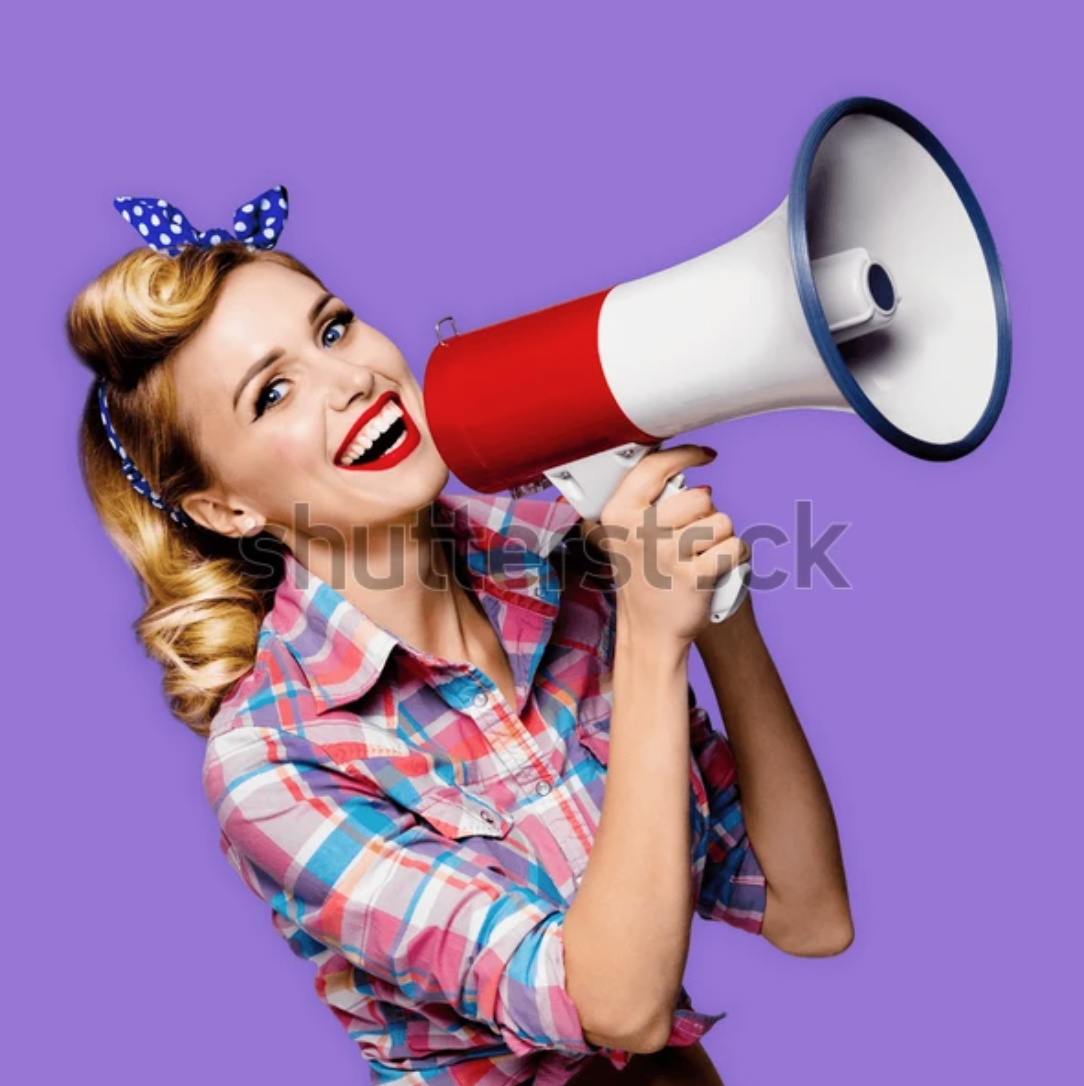
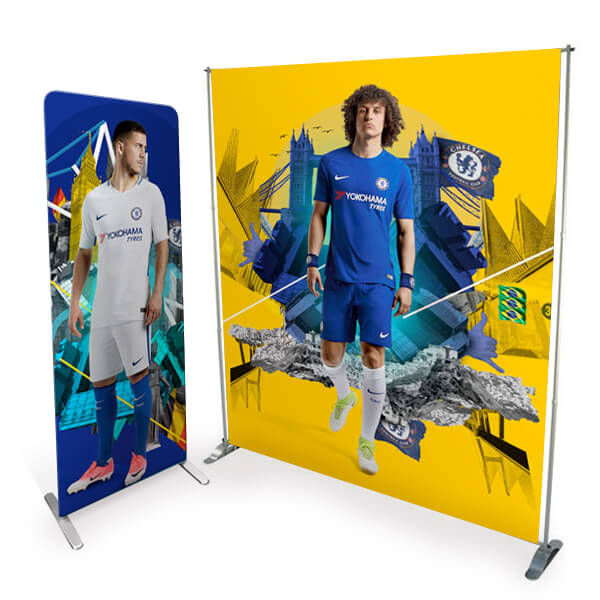
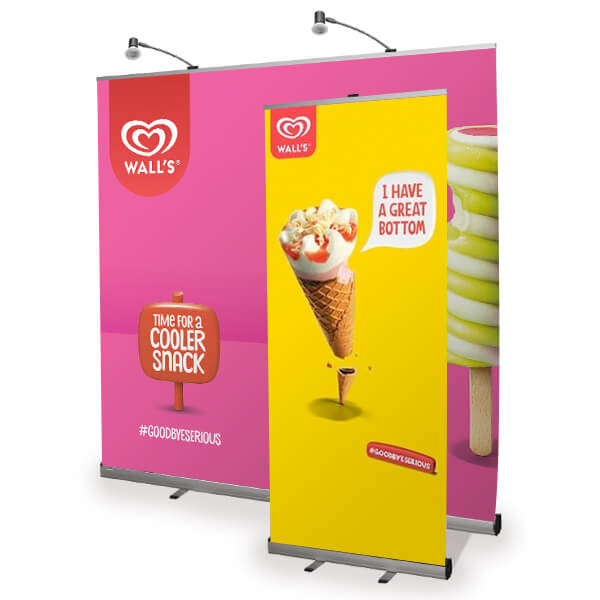
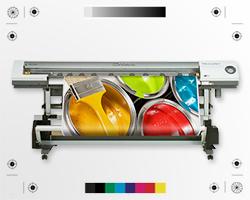
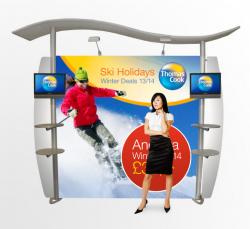
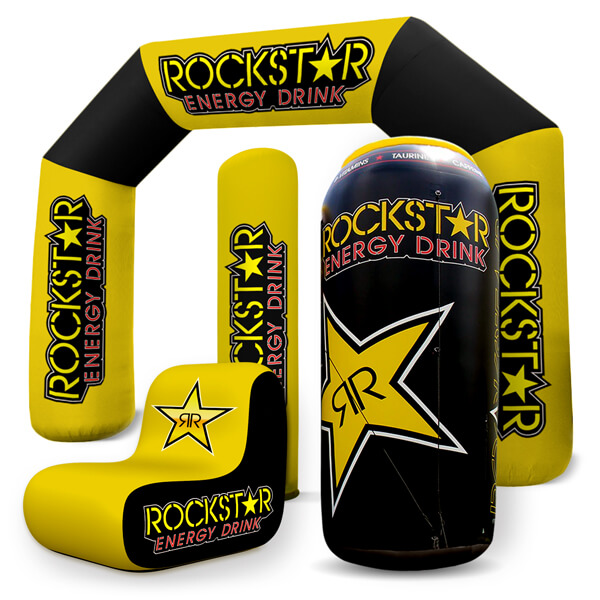

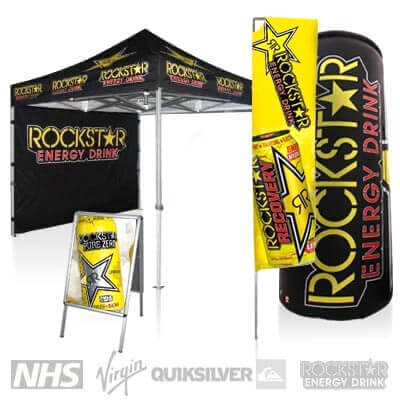
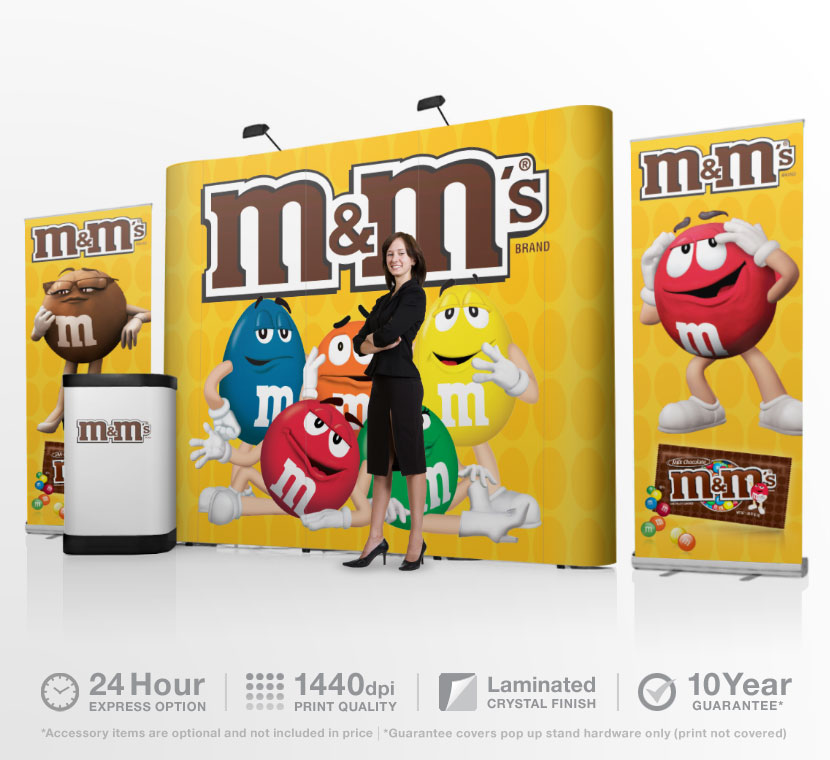
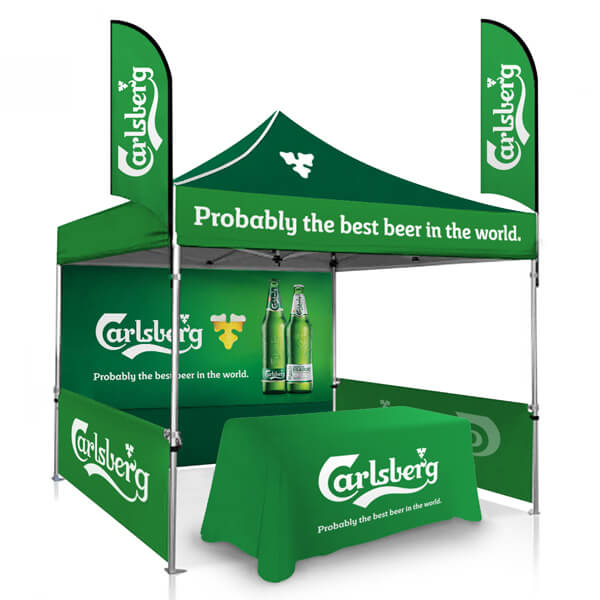
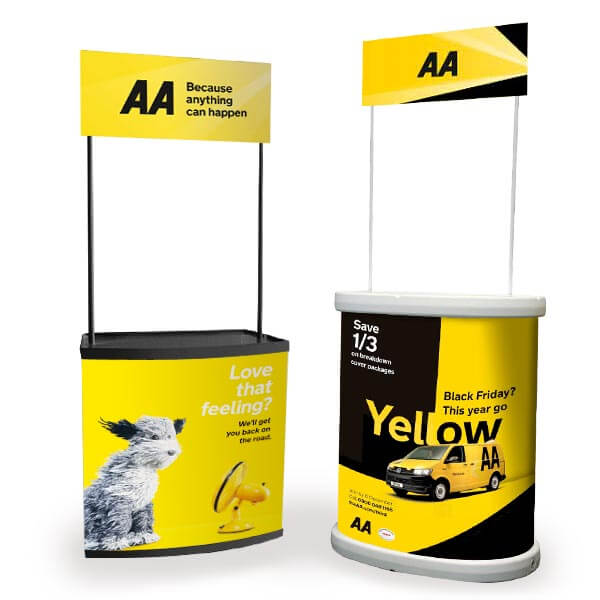

Promotional Marketing Displays (71)
Promotional marketing displays blog with information on new products and services for advertising and promotional marketing displays in London.

Poster sign stands are a versatile and cost-effective way to communicate messages in retail, event or informational settings. Essentially freestanding display units, they allow posters to be secured behind weather-proof covers or mounted on adjustable frames and poles. These stands are perfect for showcasing new promotions, directing visitors, providing safety information or simply reinforcing brand presence in high-footfall zones. Many models offer adjustable height, lockable cases and interchangeable graphics, allowing businesses to update visuals quickly without replacing hardware. From street-level promotions to indoor display applications, poster sign stands offer flexibility, portability and long-term value.
Pavement signs take sign-writing to the pavement. A-boards, swing signs and forecourt models serve as high-visibility tools right at the frontline of street traffic and passing customers. These signs typically feature double-sided poster panels or chalkboard surfaces to promote daily offers, sales, opening hours or brand identity. Their portability makes them ideal for cafés, retail storefronts, markets and outdoor event zones. Many include water-fillable bases or weighted feet to ensure stability in windy conditions. With changeable graphics or re-writable surfaces, they deliver ongoing value for businesses looking to engage foot traffic. Poster signs.
Regardless of type, the effectiveness of signage depends heavily on print quality and material durability. A high-impact sign not only catches attention but retains that attention through clarity and longevity. For this reason, premium suppliers print graphics at a high resolution—up to 1200 dpi—and apply certification standards such as B1 fire-rated materials to ensure safety compliance in regulated venues. These advanced prints use UV-stable, waterproof inks that maintain vibrancy and resist fading or wear. This level of quality ensures your signage performs professionally across repeated use, costing less over time and reflecting well on your brand.
Selecting the most suitable sign depends on your venue, audience and budget. For indoor offices or event halls where foot traffic is controlled, a poster sign stand offers a neat and flexible solution. When you’re seeking to catch retail buyers on the move, a pavement sign placed at the storefront delivers immediate visibility. If you are working outdoors in varied weather or high traffic environments, opt for models with robust frames and weather-proof materials. Whichever type you choose, look for custom printing options, changeable graphics and the ability to refresh content easily.
Top suppliers provide not just hardware but full support. That means access to design services, ready-to-print templates, and expert advice on layout, readability and outdoor performance. Fast UK nationwide delivery is another key factor—many signs leave the warehouse within days of artwork approval. For signage that needs to be set up swiftly—whether for store openings, event campaigns or pop-ups—this rapid turnaround is crucial. When combined with premium 1200 dpi printing and B1 fire-rated materials, you’re not just buying signs—you’re investing in professional, reliable visual communication.
In summary, poster sign stands and pavement signs are fundamental tools for marketing, wayfinding and brand visibility. Paired with superior print quality, safety-certified materials and responsive service, they deliver real impact at both indoor and outdoor locations—making them an essential part of any display strategy.
